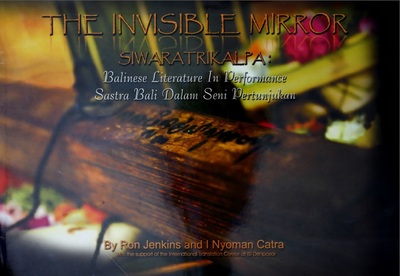Ron , Jenkins and I Nyoman, Catra and I Nyoman, Sedana and Ni Putu , Tisna Andayani and Nyoman , Lia Susanthi and Ni Wy, Suratni and Ni Kadek , Dwiyani and I Gede, Mawan and I Nyoman, Kariasa and I Wayan, Budiarsa and Made , Rai Kariasa and Teryl, Adnyata and I Gede , Agus Jaya Sadguna
(2008)
The Invisible Mirror Siwaratrikalpa : Balinese Literature In Performance Sastra Bali Dalam Seni Pertunjukan.
ISI Denpasar.
ISBN 978-979-99774-1-0
Abstract
According to Ida Pedanda Ketut Kencana Singarsa the world's troubles can all be traced to the human flaw of forgetting. "Insideneach of us, there is memory and there is forgetfulness," says the octogenarian Hindu priest, peering through his thick glasses at the faded inscriptions on a palm leaf manuscript, known in Bali as a lontar. "When we forget our relationship to the divine nature of what is unseen, we have problems. Translating lontars can help us to remember the importance of the invisible world in solving our problems. If you want to see a reflection of the human body, look in a mirror. If you want to see a reflection of the human mind, look at a lontar"
this book is an attempt to follow Ida Pedanda's advice and look at literature as a mirror of the Balinese soul, an invisible mirrir that reflects the truth of the invisible world or 'niskala.' An important example of Balinese sastra literature is "Siwaratrikalpa," a poem that tells the story of Lubdaka, a hunter who unwittingly atones for his lifetime of killing animals by staying awake all night in a forest on the scared night of Siwa (Siwaratri). He climbs a Bila tree to avoid being attacked by wild beasts and plucks leaves to keep himself from sleeping and falling out of the tree. Years later, when Lubdaka dies, the armiws of hell and heaven battle over the hunter's soul, but ultimately his unconscious enactment of Siwa's ritual wins him a place in heaven.
This book includes three versions of the Lubdaka story. The first is a condensation of the narrative's essential meaning as interpreted by a high Hindu priest, Ida Pedanda Ketut Kencana Singarsa. The second version of the story comes from a storyteller (I Ketut Jagra) whose improvised narrative in the tradition Balinese 'satua' was broadcast on Radio Republik Indonesia (RRI). The third retelling of the Lubdaka story takes the from af a wayang shadow puppet play that was performed in Denpasar's Puputan field by three dalang puppet master, I Ketut Kodi (ebs)
Most Balinese children hear the story of Lubdaka in elementary school, but it is also encountered in other forms, like babaosan chanting in religious ceremonies or wayang shadow puppet play. In all its variations Lubdaka's encounter with the invisible worlds of heaven and hell is recounted as a cautionary tale to remind the readers, listeners, a spectators that their fate also depends on their relationship with what cannot be seen.
Actions (login required)
 |
View Item |
![[img]](http://repo.isi-dps.ac.id/1780/1.hassmallThumbnailVersion/cover_the_invisible_mirror.jpg)



